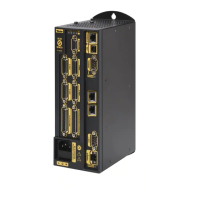Parker Hannifin
EPL IP Addresses
An EPL network is a private Class C network with Net ID 192.168.100.0. The
first 3 octets will always be 192.168.100 for all EPL nodes. The node ID of an
individual node will be the last octet of the EPL IP address of that node. For
example, if an EPL drive has the address of 97 on its switch settings, its IP
address will be 192.168.100.97. The correlation of node ID with network IP is
required because EPL uses TCP/IP as part of the protocol.
The EPL IP address is not related in any way to the standard Ethernet IP
address given with the IP command. There is no need to change any part of
the EPL IP address other than the last octet.
EPL and CANopen Standards
The ETHERNET Powerlink V2.0 draft standard calls for the use of CANopen
as the data exchange protocol. In this case, CANopen describes the use of
object dictionaries, device profiles, data exchange methods, and network
control. Ethernet is used as the physical medium, not CANbus.
Both EPL and CANopen device profiles are open standards, so all vendors’
equipment will work together to the extent that they support the standards.
The CANopen device profile for drives and motion control is CiA DSP-402.
EPL drives must conform to this standard, and EPL controllers such as the
ACR9030 and ACR9040 expect to find drives that conform to CiA DSP-402.
To ensure product compatibility, please contact Parker Electromechanical
Division before specifying a multi-vendor EPL solution.
Cabling and SETUP
ACR9030, ACR9040, and Aries EPL devices are equipped with dual
ETHERNET Powerlink ports which can handle lines and branches. Therefore,
any topology such as line, tree, star, or mixed structures can be realized.
Inside each device, a repeating hub forwards the data stream to its intended
destination. In addition to greater flexibility, this reduces the need for external
infrastructure components such as switching or repeating hubs.
With ETHERNET Powerlink, the physical and the logical topology of the
network are separated. It is possible to connect a device to any port on the
network without having to reconfigure it. This achieves a higher degree of
freedom with designing and upgrading modular machine systems and
prevents cabling errors.
Two EPL connectors are located on the ACR9030 and ACR9040 front panel
and are labeled ETHERNET POWERLINK. (This is not to be confused with
the LAN communications port labeled ETHERNET.) See Figure 43 for the
ACR9030 front panel and Figure 44 for the ACR9040 front panel. Both EPL
ports are available to the user. An internal hub allows the use of either or
both of the connectors for wiring the EPL network, allowing for cabling
simplification.
164 ACR9000 Series Hardware Installation Guide
www.comoso.com

